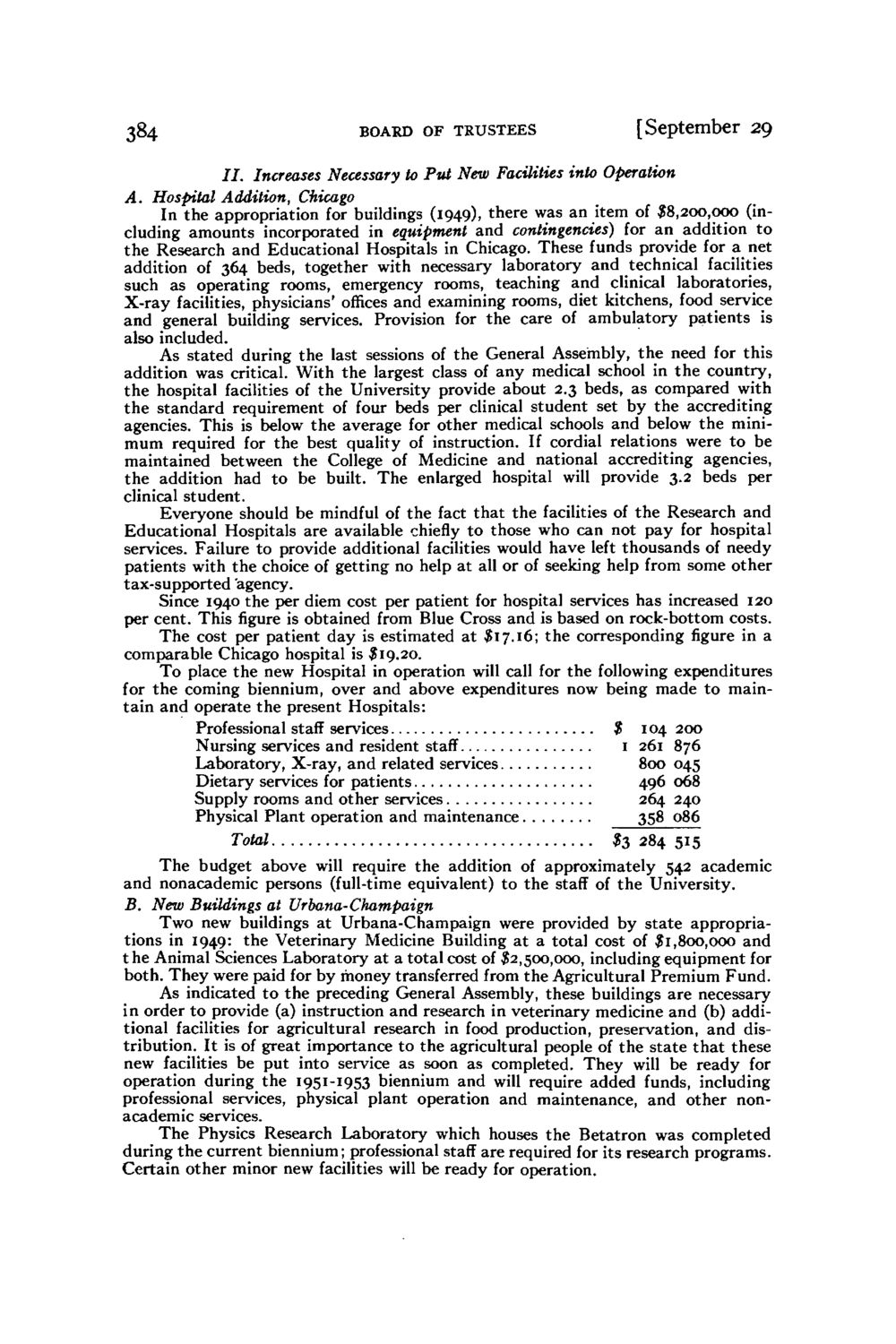| |
| |
Caption: Board of Trustees Minutes - 1952
This is a reduced-resolution page image for fast online browsing.

EXTRACTED TEXT FROM PAGE:
384 BOARD OF TRUSTEES [September 29 II. Increases Necessary to Put New Facilities into Operation A. Hospital Addition, Chicago In the appropriation for buildings (1949), there was an item of $8,200,000 (including amounts incorporated in equipment and contingencies) for an addition to the Research and Educational Hospitals in Chicago. These funds provide for a net addition of 364 beds, together with necessary laboratory and technical facilities such as operating rooms, emergency rooms, teaching and clinical laboratories, X-ray facilities, physicians' offices and examining rooms, diet kitchens, food service and general building services. Provision for the care of ambulatory patients is also included. As stated during the last sessions of the General Assembly, t h e need for this addition was critical. With the largest class of any medical school in t h e country, the hospital facilities of the University provide about 2.3 beds, as compared with the standard requirement of four beds per clinical student set by the accrediting agencies. This is below the average for other medical schools and below the minimum required for the best quality of instruction. If cordial relations were to be maintained between the College of Medicine and national accrediting agencies, the addition had to be built. The enlarged hospital will provide 3.2 beds per clinical student. Everyone should be mindful of the fact that the facilities of the Research and Educational Hospitals are available chiefly to those who can not pay for hospital services. Failure to provide additional facilities would have left thousands of needy patients with the choice of getting no help at all or of seeking help from some other tax-supported agency. Since 1940 the per diem cost per patient for hospital services has increased 120 per cent. This figure is obtained from Blue Cross and is based on rock-bottom costs. The cost per patient day is estimated at $17.16; the corresponding figure in a comparable Chicago hospital is $19.20. To place the new Hospital in operation will call for the following expenditures for the coming biennium, over and above expenditures now being made to maintain and operate the present Hospitals: Professional staff services $ 104 200 Nursing services and resident staff 1 261 876 Laboratory, X-ray, and related services 800 045 Dietary services for patients 496 068 Supply rooms and other services 264 240 Physical Plant operation and maintenance 358 086 Total $3 284 515 The budget above will require the addition of approximately 542 academic and nonacademic persons (full-time equivalent) to the staff of the University. B. New Buildings at Urbana-Champaign Two new buildings at Urbana-Champaign were provided by state appropriations in 1949: the Veterinary Medicine Building at a total cost of $1,800,000 and t h e Animal Sciences Laboratory at a total cost of $2,500,000, including equipment for both. They were paid for by money transferred from the Agricultural Premium Fund. As indicated to the preceding General Assembly, these buildings are necessary in order to provide (a) instruction and research in veterinary medicine and (b) additional facilities for agricultural research in food production, preservation, and distribution. It is of great importance to the agricultural people of the state t h a t these new facilities be put into service as soon as completed. They will be ready for operation during the 1951-1953 biennium and will require added funds, including professional services, physical plant operation and maintenance, and other nonacademic services. The Physics Research Laboratory which houses the Betatron was completed during the current biennium; professional staff are required for its research programs. Certain other minor new facilities will be ready for operation.
| |